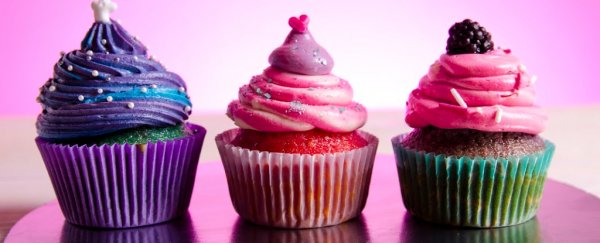Let's say you've been watching a lot of trendy baking videos on YouTube, and decide to make some unicorn cupcakes for the next workplace potluck.
You rush down to the cake store, grab some 'non-toxic' glitter, and add it liberally into the icing, without realising that what you're buying is no more edible than pieces of a plastic water bottle.
The US Food and Drug Administration (FDA) has just sent out a consumer update (and a video with a great backing track which you can listen to below) to help you tell the difference between what is actually edible and what's not.
So, according to the FDA, truly edible glitters are usually made of "sugar, acacia (gum arabic), maltodextrin, cornstarch, and colour additives specifically approved for food use, including mica-based pearlescent pigments and FD&C colours."
This will be on the label – so if you can't find a label with an actual ingredients list on it, it's not a food. And that's a problem, because not all 'cake glitter' you can buy is indeed food.
As the FDA explains, "some decorative glitters and dusts promoted for use on foods may, in fact, contain materials that should not be eaten."
Instead of saying edible, these products might be labelled as 'non-toxic'. This is a pretty sure-fire way to know that the thing you're putting into your cake is mostly plastic.
Glitter is made by combining plastic, colouring and a reflective material such as aluminium, or titanium dioxide. The non-toxic stuff is made of ingredients that are inert, but there's no guarantee that this stuff is supposed to be eaten.
So if you've eaten any, should you be worried? Well, if you managed to not inhale it into your lungs, you're probably okay.
"It'll probably just go straight through you," Andrew Stolbach, a medical toxicologist at Johns Hopkins University School of Medicine, told Refinery 29.
But don't think that means it's fair game to sprinkle all over your cupcakes. Plastic water bottles and playdough are also 'non-toxic', but you probably wouldn't add them into your cake mix.
There are some concerns that while the plastic itself isn't harmful, it does have a way of clinging onto other substances that are - so glitter, which is basically a microplastic, may be accompanied by unwelcome gatecrashers if we ingest it. Whether or not this can be harmful to us in the long term is unclear, though.
And the problem doesn't end there. We still have the issue of the plastic itself, once it's out of your system.
With the slew of problems caused by microplastics in the environment and in our bodies, some scientists want to see glitter made of plastic banned entirely.
"When people think about glitter, they think of party and dress-up glitter," Trisia Farrelly, an environmental anthropologist at Massey University, told The Independent last year.
"But glitter includes cosmetic glitters as well, the more everyday kind that people don't think about as much."
According to Wikipedia, 4.5 million kilograms (10 million pounds) of glitter was purchased between 1989 and 2009 alone, and although we'll have to take that figure with a grain of salt, our glitter obsession might be getting a little out of hand.
So keep an eye out for what sort of glitter you're buying, especially if you want to decorate your food.

